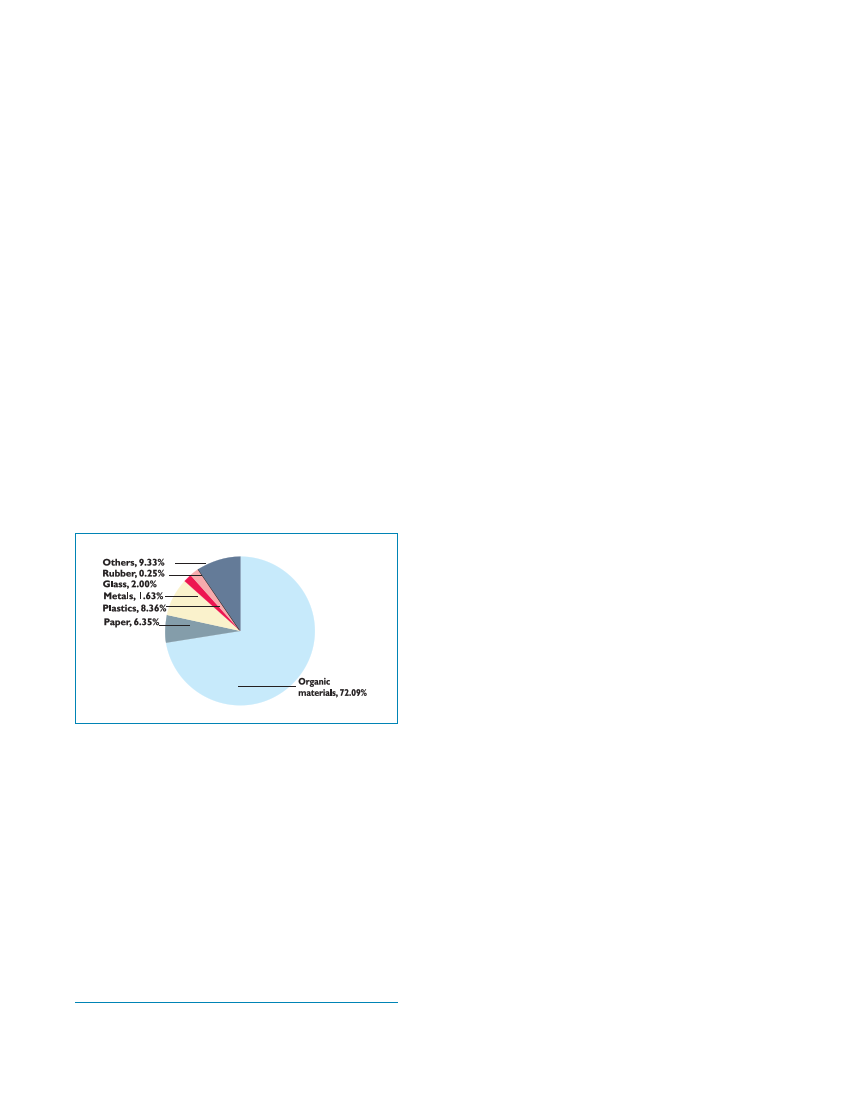
BEST PRACTICES ON SOLID WASTE MANAGEMENT OF NEPALESE CITIES
to coordinate with governmental organisations, NGOs and
INGOs for effective management and partnership, and to
extend an effective door-to-door solid waste collection
service to different urban centres in Nepal. To ignite this
process, NEPCEMAC started with an area cleanliness
campaign, in which they involved all the residents in an
area, to come together and clean their surroundings.
Waste generation and composition
According to the data provided by NEPCEMAC and the
field surveys conducted in June 2008, the average HH
waste generation rate in LSMC area is 0.37kg/capita/
day (NEPCEMAC, 2008 data). This rate is higher than the
national average of 0.25kg/capita/day and less than the
rate for Kathmandu metropolitan, which is 0.39kg/capita/
day (SWMRMC, 2008 data). The composition of the waste
has been found to be: 72.09 per cent organic waste, 6.35
per cent paper, 8.36 per cent plastic, 1.63 per cent metal,
2.00 per cent glass, 0.25 per cent rubber, and 9.33 per
cent other materials (NEPCEMAC, 2008 data).
Chart 6: Composition of solid waste of Lalitpur
recyclable waste is dumped at locations designated by
the respective municipality27 .
Transport and final disposal
There are different means of final disposal, according
to the provisions made by the respective municipalities.
In the case of LSMC, NEPCEMAC unloads some of the
waste it collects into containers (capacity 6 tons) and
also at the Bagmati river bank dumpsite (allocated by
LSMC). In Kathmandu metropolitan city, NEPCEMAC
transports waste using its own vehicles (two tipper
trucks of 4 tons capacity) to the Sisdol landfill site.
NEPCEMAC has become one of the major NGOs working
in solid waste collection, composting and haulage.
Organisational and
financial aspects
According to the data provided by NEPCEMAC, it employs
174 staff - 21non-technical, 52 technical and 101 general
- as regular full-time staff, and 100 daily-waged
labourers (NEPCEMAC, 2007 data). The income of this
organisation is derived from waste collection charges,
and sales of compost etc. In 2007, the income of
NEPCEMAC was NRs.20 million (NEPCEMAC, 2007 data).
Waste collection and recycling
The NEPCEMAC programme has expanded its door-to-
door waste collection into other areas of Lalitpur. Now,
the working area of NEPCEMAC covers 13,000 HHs -
all of Wards no. 3, 4, 5 and 13 and parts of Wards 2,
14, 19 and 20 of Lalitpur sub-metropolitan city area
and Wards no. 2, 3, 4, 5, 15 and 16 of Kathmandu
metropolitan city (NEPCEMAC, 2008 data). It has slowly
extended its operational area to other urban centres of
the country. NEPCEMAC is collecting HH waste from
door to door between 7 a.m. and 9 a.m. each morning.
The NGO has promoted HH composting. All non-
Waste collection charges are NRs.125 per house and
NRs.50 to NRs.75 per shop (NEPCEMAC, 2007 data).
The expenditure of this organisation is approximately
the same as the income, according to a NEPCEMAC
source, so they have achieved breakeven status as
far as operational costs are concerned. It is one of
the largest NGOs working in waste management in
Nepal. This NGO is not only improving its waste
management system, but is also creating many jobs
for poor urban citizens.
Major problems and issues
Despite its effective door-to-door waste collection
service, NEPCEMAC is facing a poor response to its
calls for citizens to minimise the amount of waste that
they discard. It has distributed red and green bins (each
with a capacity of 10 kilograms) for waste segregation
at source to 1000 HHs but waste collectors from
27 Regarding LSMC case, it has provided containers of capacity 7 tons in working areas of
NEPCEMAC
30